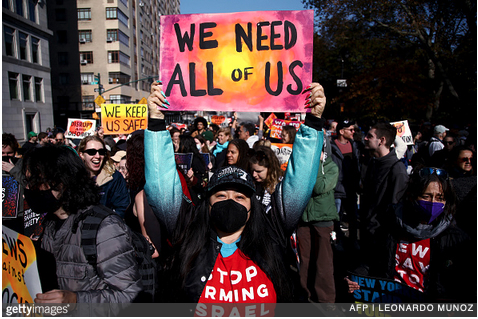If it seems like there are more hate crimes now than ever, that’s because it’s true. New data released by the FBI Tuesday indicates a 17 percent increase in hate crimesreported—and that’s just for 2017. Tellingly, nearly 60 percent of those hate crimes are tied to race.
In 2017, 16,149 law enforcement agencies participated in the Hate Crime Statistics Program. Of these agencies, 2,040 reported 7,175 hate crime incidents involving 8,437 offenses.
Of the 8,126 single-bias hate crime offenses reported in the above incidents:
- 59.5 percent stemmed from a race/ethnicity/ancestry bias.
- 20.7 percent were motivated by religious bias.
- 16.0 percent resulted from sexual-orientation bias.
- 1.6 percent resulted from bias against disabilities.
- 1.6 percent stemmed from gender-identity bias.
- 0.7 percent (53 offenses) were prompted by gender bias.
Of the race-based hate crimes, nearly half were against African-Americans. Nearly 60 percent of the hate crimes driven by religion were anti-Semitic in nature, with Islamophobic attacks coming in a distant second. Gay men were the most targeted (58.6 percent) when it came to hate crimes driven by sexual orientation, with a “mixed group” of lesbian, transgender, and/or bisexual members of the LGBTQ community the targets of nearly a quarter of the violence.
See the trend? The vast majority of these acts of violence are being aimed at blacks, Jews, and members of the LGBTQ community—not the cisgender, heterosexual, white Christian men that we instinctively know to be the proponents of most of this bigoted violence.

Again, this data covers 2017. After the hellscape that far-right hate delivered to the nation in recent weeks, one can only wonder what 2018’s data will show. It’s also worth noting that not all law enforcement agencies track and report hate crimes to the FBI, though the federal agency is encouraging them to.
The FBI is working with law enforcement partners across the country to encourage reporting of hate crime statistics. Next year, FBI personnel will provide training for law enforcement officers on how to identify bias-motivated incidents and report that data to the FBI’s (Uniform Crime Reporting) Program.
If it seems a bit odd to you that the FBI is waiting until 2019 to train its law enforcement officers on how to identify “bias-motivated incidents” after the United States’ lengthy history of those very types of crimes, you’re not alone. Last week’s jaw-dropping report from the New York Times shows just how unprepared law enforcement agencies are when it comes to dealing with white supremacist violence.
Lieutenant Dan Stout, in Gainesville, Florida, paints a chilling picture of how little guidance was available as his department attempted to prepare for an appearance by alt-right leader Richard Spencer last autumn, shortly after the deadly violence in Charlottesville.
There were no current intelligence reports he could find on the alt-right, the sometimes-violent fringe movement that embraces white nationalism and a range of racist positions. The state police couldn’t offer much insight. Things were equally bleak at the federal level. Whatever the F.B.I. knew (which wasn’t a lot, Stout suspected), they weren’t sharing. The Department of Homeland Security, which produced regular intelligence and threat assessments for local law enforcement, had only scant material on white supremacists, all of it vague and ultimately not much help. Local politicians, including the governor, were also in the dark.
This is like a Bermuda Triangle of intelligence, Stout thought, incredulous.
Spencer’s speech, of course, was ultimately a massive failure, with more protesters than supporters in attendance. But violence still followed, because again and again, despite the clean-cut image that Spencer and groups like the Rise Above Movement and Gavin McInnes’ Proud Boys try to cultivate—an image that relies on stereotypes of inherent white goodness—brutal violence is what the alt-right does best.

But how can law enforcement be so woefully unprepared and uninformed? Because, just like Donald Trump’s rhetoric, the New York Times reports, they’ve been focused on the wrong people.
White supremacists and other far-right extremists have killed far more people since Sept. 11, 2001, than any other category of domestic extremist. The Anti-Defamation League’s Center on Extremism has reported that 71 percent of the extremist-related fatalities in the United States between 2008 and 2017 were committed by members of the far right or white-supremacist movements. Islamic extremists were responsible for just 26 percent.
[…]
These statistics belie the strident rhetoric around “foreign-born” terrorists that the Trump administration has used to drive its anti-immigration agenda. They also raise questions about the United States’ counterterrorism strategy, which for nearly two decades has been focused almost exclusively on American and foreign-born jihadists, overshadowing right-wing extremism as a legitimate national-security threat.
P.W. Singer, a national security strategist at the New America think tank, tells the Times that, while the Trump administration was adamant about keeping a laser focus on Muslim extremism, despite being warned about right-wing racists, this blind spot existed long before his inauguration.
[E]ven before the Trump administration, he says, “we willingly turned the other way on white supremacy because there were real political costs to talking about white supremacy.”
Singer’s right. In 2009, in the wake of Barack Obama’s election and the activation by his presidency of all those crazed bigots, the Department of Homeland Security released a report on right-wing extremism, and all hell broke loose. A senior intelligence analyst named Daryl Johnson wrote the report, as the head of a rinky-dink Homeland Security domestic-terrorism unit. In an interview with Janet Reitman, Johnson muses about the unexpectedly powerful impact his report had—and a creeping double standard.
Several G.O.P. lawmakers called for [DHS Secretary Janet] Napolitano’s resignation, as well as that of Johnson, who, in their view, equated conservatives with terrorists.
“I never anticipated such an aggressive, vile backlash,” he told me recently. It was puzzling: Just a few months before his April 2009 report was published, the department released an assessment of the cyber threat posed by “left-wing extremists.”
[…]
Legislators, the media and the public at large — including progressives — had no objection to that terminology. But the political firestorm over “right-wing extremism” had caused such an uproar that the Department of Homeland Security ultimately avoided using ideological terminology like “right-wing.”
A few weeks after the report was released, Napolitano formally apologized to veterans, and after intense pressure from veterans’ groups, the department withdrew the report.
Nearly ten years later, we’re deep in a soup of unapologetic and mainstream white hate, with its proponents convinced that the American president agrees with them. And law enforcement isn’t just ill-equipped to deal with these hateful folks; in some cases, they’re indulging them, enabling them, or just trying to ignore them.
Cops would stand watch at events, sometimes on horseback, and while they might not have been ideologically aligned with the alt-right, they still tolerated them.
[…]
One Houston activist … recalls a rally where the police posed for pictures with members of the alt-right. “Very buddy-buddy,” he says.
[…]
One domestic-terrorism expert who conducts hate-crimes training for law enforcement was baffled by the pushback she received from police officers who didn’t seem to view white-supremacist groups as a law-enforcement problem. “They’d say things like, ‘Why aren’t you calling Black Lives Matter or Antifa a hate group?’ The answer is, because they’re not hate groups! But they didn’t see it that way.”
Of course, these mindsets align perfectly with the epidemic of police brutality that has long had our nation, and people of color, particularly African-Americans, in its grip. These mindsets feed Muslim bans and border-wall fervor. But, as Don Lemon said at the end of October, we’ve got it all wrong.
[W]e have to … realize the biggest terror threat in this country is white men, most of them radicalized to the right, and we have to start doing something about them. There is no travel ban on them. There is no ban on—you know, they had the Muslim ban. There is no white guy ban.
So, what do we do about that?
It’s a crucial question, and one that’s not easy to answer, especially with an unapologetic “nationalist” in the White House.


